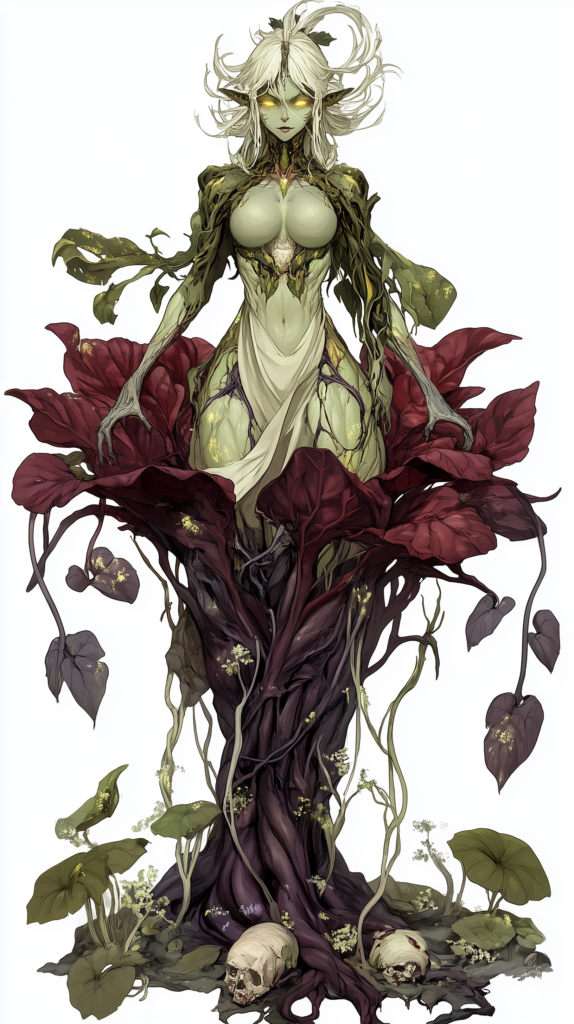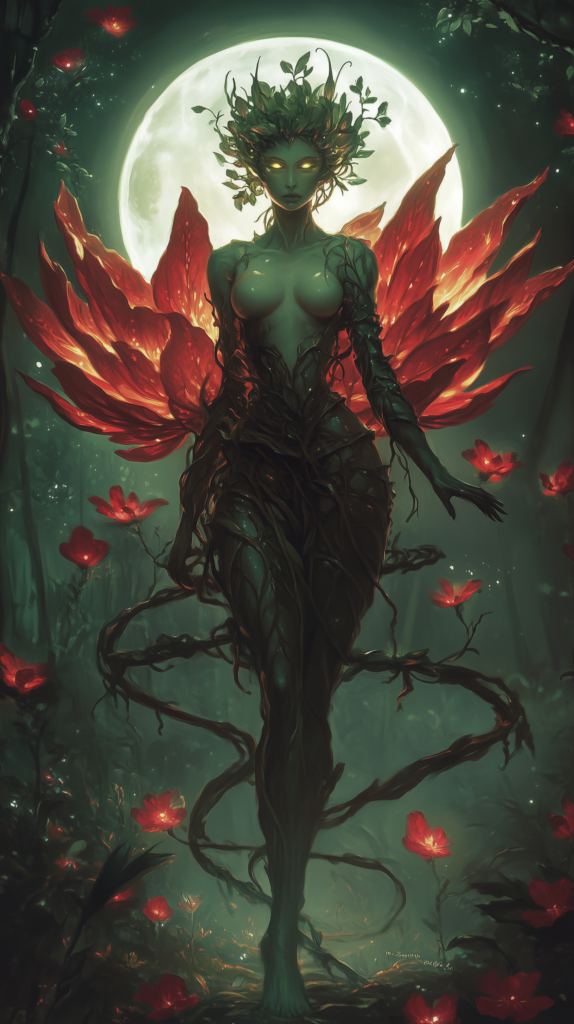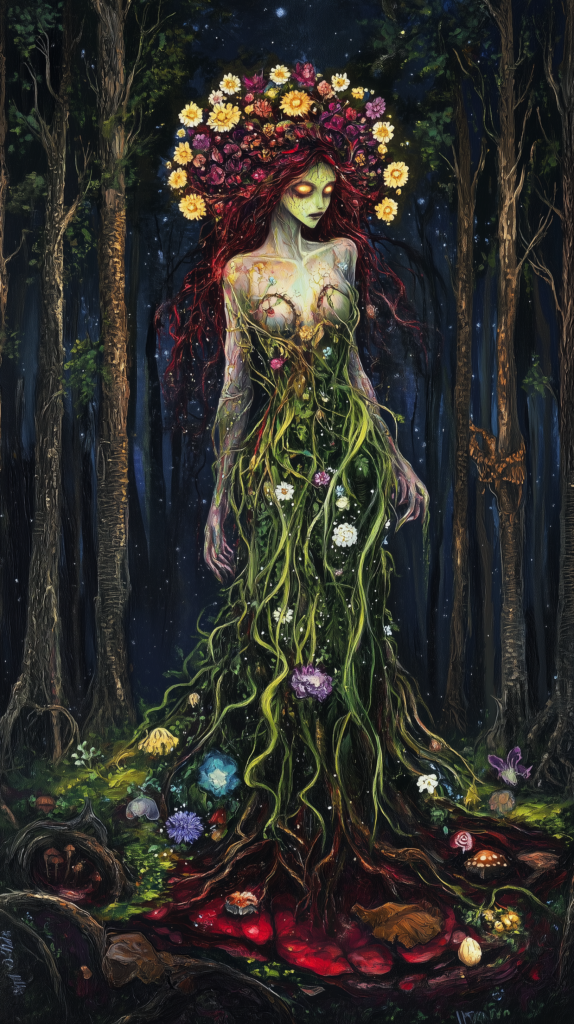Alraune, The Enchantresses of the Verdant Throne
“Beware the seductive plant-woman born of dark magic, whose beauty conceals deadly secrets!”

The Alraune is a humanoid-plant hybrid with a hauntingly ethereal beauty that masks its sinister nature. Its upper body resembles a strikingly attractive human woman with unnaturally smooth, petal-soft skin in shades of pale green, violet, or ivory. Long, vine-like hair cascades down its back, shimmering with dew and often entwined with delicate flowers or sharp thorns. Its eyes glow faintly, like bioluminescent orbs, and its lips are a vivid red, as if perpetually stained with blood. Below the waist, the Alraune’s body merges seamlessly into a massive flower or plant bulb, often resembling a carnivorous bloom with fleshy petals, dripping nectar, and tendrils that can coil like serpents.
Behaviour
The Alraune is both alluring and predatory. It exudes an intoxicating scent that lures its prey closer, a mix of sweet nectar and pheromones designed to cloud judgment and evoke desire or trust. Though capable of feigning warmth or vulnerability, the Alraune is manipulative, cruel, and cunning. It thrives on deception, using charm to lure its victims into a false sense of security before striking. Despite its beauty, the Alraune has a primal, vicious side that surfaces when threatened, its elegance giving way to savage aggression.
Habitat
Alraunes dwell in secluded, lush environments teeming with life and decay, such as dense forests, overgrown ruins, or hidden groves. These areas are rich in magical or supernatural energy, which the Alraune absorbs to sustain itself. Its lair is often surrounded by thorny undergrowth, carnivorous plants, or fungi, forming a natural defense system. Within its domain, the Alraune’s influence transforms the land into a twisted, surreal garden, with flowers and vines pulsating as if alive.
Modus Operandi
The Alraune’s primary tactic is seduction and entrapment. Using its fragrance and hypnotic allure, it draws travelers, animals, or even other magical beings into its lair. It may pose as a harmless maiden in distress, begging for help or offering companionship. Once its victim is close, the Alraune strikes: its tendrils ensnare the prey, and its flower-like body releases paralytic toxins or acid. It feeds on its victim’s life force, leaving behind lifeless husks or turning them into nutrients for its garden. Occasionally, it may enslave particularly strong or valuable individuals, binding them with magical vines to serve as guardians or thralls.
Motivation
The Alraune’s primary motivation is survival and the amplification of its power. As a being born of unnatural magic or cursed origins, it seeks to dominate its surroundings, expanding its domain and influence. Some legends suggest that the Alraune harbors a deep-seated hatred for humanity, born of its own dark creation, and delights in corrupting or destroying those who fall under its spell. Others portray it as a tragic figure, driven by an insatiable hunger it cannot control, longing for freedom from its monstrous nature yet resigned to its role as a predator.
Alraune 5e
Alraune Pathfinder
Alraune

Medium Fey (Plant), Neutral Evil
Armor Class: 16 (Natural Armor)
Hit Points: 136 (16d8 + 64)
Speed: 30 ft., burrow 10 ft.
| STR | DEX | CON | INT | WIS | CHA |
|---|---|---|---|---|---|
| 15 (+2) | 16 (+3) | 18 (+4) | 14 (+2) | 14 (+2) | 20 (+5) |
Saving Throws: Dex +6, Con +7, Cha +8
Skills: Deception +8, Persuasion +8, Nature +5, Stealth +6
Damage Resistances: Acid, Psychic, Poison
Damage Vulnerabilities: Fire
Condition Immunities: Charmed, Poisoned
Senses: Darkvision 60 ft., Passive Perception 12
Languages: Common, Sylvan, telepathy 60 ft.
Challenge: 8 (3,900 XP)
Traits
Luring Scent. The Alraune exudes an intoxicating fragrance that affects creatures within 30 feet. Any creature that starts its turn in this radius must succeed on a DC 16 Wisdom saving throw or be charmed until the start of its next turn. While charmed in this way, a creature is incapacitated and has a speed of 0. A creature that succeeds on the saving throw is immune to this effect for 24 hours.
Plant Camouflage. The Alraune has advantage on Dexterity (Stealth) checks made to hide in natural terrain.
Magic Resistance. The Alraune has advantage on saving throws against spells and other magical effects.
Actions
Multiattack. The Alraune makes two Tendril Lash attacks and uses either Luring Petals or Ensnaring Vines if available.
Tendril Lash. Melee Weapon Attack: +6 to hit, reach 15 ft., one target.
Hit: 15 (2d10 + 2) slashing damage, and the target must succeed on a DC 16 Strength saving throw or be grappled (escape DC 16). While grappled, the target is restrained.
Luring Petals (Recharge 5–6). The Alraune unfurls her massive flower, releasing a dazzling array of petals. Each creature of the Alraune’s choice within 60 feet that can see her must succeed on a DC 16 Wisdom saving throw or be charmed for 1 minute. While charmed in this way, a creature treats the Alraune as a trusted ally and will defend her. A creature charmed by this ability can repeat the saving throw at the end of each of its turns, ending the effect on a success.
Ensnaring Vines. The Alraune causes thorny vines to erupt from the ground in a 20-foot radius centered on her. Each creature in the area must make a DC 16 Strength saving throw or be restrained for 1 minute. A creature restrained in this way takes 7 (2d6) piercing damage at the start of its turn. A restrained creature can use its action to make a Strength (Athletics) check against the DC, freeing itself on a success.
Sap Spray (Recharge 6). The Alraune sprays a cone of sticky, glowing sap in a 30-foot cone. Each creature in the cone must make a DC 16 Dexterity saving throw or be covered in sap. A creature covered in sap is blinded and restrained. A creature can spend an action to scrape the sap off itself or another creature.
Reactions
Thorned Retaliation. When a creature within 5 feet hits the Alraune with a melee attack, it takes 7 (2d6) piercing damage as thorns lash out from her body.
Tactics
The Alraune is a cunning predator that uses charm and control to isolate and subdue her prey.
- She begins combat with Luring Petals, attempting to charm as many enemies as possible.
- She uses Ensnaring Vines to immobilize enemies, keeping them within her reach.
- Once opponents are restrained, she attacks with Tendril Lash, prioritizing weaker enemies or those attempting to break her charm effects.
- If overwhelmed, the Alraune will use Sap Spray to incapacitate groups and retreat into thick vegetation, using Plant Camouflage to hide.
The Alraune prefers to fight in environments where her abilities can be maximized, such as dense forests or overgrown ruins. She uses her Luring Scent to draw prey into these areas before ambushing them.
Legendary Actions (Optional for High-Level Games)
The Alraune can take 1 legendary action at the end of another creature’s turn.
- Petal Shield. The Alraune briefly hardens her petals, gaining +2 to AC until the start of her next turn.
- Nature’s Aid. The Alraune summons a small plant creature (like a vine blight or awakened shrub) within 30 feet to fight for her.
Alraune

An attractive green-skinned woman sits in the depths of this enormous, sweet-smelling flower.
Alraune is a novel by German novelist Hanns Heinz Ewers published in 1911. It is also the name of the female lead character.
The story of Alraune dates to the Middles Ages in Germany. The humanoid-shaped Mandrake root or Mandragora officinarum was widely believed to be produced by the semen of hanged men under the gallows. Alchemists claimed that hanged men ejaculated after their necks were broken and that the earth absorbed their final “strengths”. In some versions, it is blood instead of semen. The root itself was used in love philtres and potions while its fruit was supposed to facilitate pregnancy. Witches who “made love” to the Mandrake root were said to produce offspring which had no feelings of real love and had no soul.
Fiction
The novel deviates from the myth by concentrating on the issues of artificial insemination and individuality: genetics versus environment. A scientist, Professor Jakob ten Brinken, interested in the laws of heredity, impregnates a prostitute in a laboratory with the semen of a hanged murderer. The prostitute conceives a female child who has no concept of love, whom the professor adopts. The girl, Alraune, suffers from obsessive sexuality and perverse relationships throughout her life. She learns of her unnatural origins and she avenges herself against the professor.
| Alraune CR 13 |
| XP 25,600 NE Large plant Init +5; Senses Low-Light Vision; Perception +17 Aura calming fragrance (60 ft., DC 24) |
| DEFENSE |
| AC 27, touch 10, flat-footed 26 (+1 Dexterity, +17 natural, -1 size) hp 199 (19d8+114) Fort +17, Ref +9, Will +11 Immune plant traits; SR 24 |
| OFFENSE |
| Speed 40 ft. Melee 4 vines +20 (1d10+7 plus grab and bleed) Space 10 ft.; Reach 10 ft. Special Attacks bleed (2d6), constrict (1d10+10), feed Spell-Like Abilities (CL 13th; concentration +18) At willcharm monster (DC 18), detect thoughts (DC 17), suggestion (DC 18) 3/dayquickened glitterdust (DC 17), hold monster (DC 20) 1/daycommune with nature, mind fog, wall of thorns |
| STATISTICS |
| Strength 24, Dexterity 13, Constitution 22, Intelligence 10, Wisdom 17, Charisma 21 Base Atk +14; CMB +22 (+26 grapple); CMD 33 (can’t be tripped) Feats Alertness, Cleave, Deceitful, Great Cleave, Improved Initiative, Iron Will, Lightning Reflexes, Power Attack, Quicken Spell-Like Ability (glitterdust), Vital Strike Skills Bluff +16, Disguise +9, Knowledge (nature) +9, Perception +17, Sense Motive +14 Languages Aklo, Common, Elven, Sylvan |
| SPECIAL ABILITIES |
| Calming Fragrance (Su) A supernaturally sweet perfume that calms the nerves and blunts aggression constantly surrounds an alraune to a radius of 60 feet. Any creature in this area of effect must make a DC 24 Will save at the start of its turn to avoid falling under the effects of calm emotions for 1 round. Creatures that could be attracted to the alraune’s current apparent gender take a -2 penalty on this Will save, while all other creatures gain a +2 bonus on the save. This is a mind-affecting effect. The save DC is Charisma-based. Feed (Ex) An alraune’s roots can feed on a helpless or willing target. At the end of an hour of feeding, the victim takes 1d6 points of both Constitution and Intelligence drain, and the alraune heals 3d6 points of damage. |
| ECOLOGY |
| Environment temperate forests Organization solitary Treasure standard |
An alraune relies on its supernaturally soothing odor to render enemies incapable of making hostile acts against iteven if the alraune attacks a foe, its calming scent can wipe away any thoughts of violence from its prey. At rest, an alraune appears to be merely a large thorny plant with a single enormous and brightly colored flower at its center.
When an alraune attacks, its thorny vines lash out and its flower blooms, revealing an attractive, green-skinned humanoid form within. An alraune’s apparent gender can vary even from encounter to encounter, for the plant can reshape its humanoid portions as it desires to increase the likelihood of setting its victims at ease. Regardless of the plant’s apparent gender, it is itself asexual and reproduces (typically once or twice per decade) by budding a single offspring over the course of a spring season.
Despite their appearance, alraunes are quite mobile (capable of walking almost like a spider upon their numerous long roots and thorny vines). They hunt by using commune with nature to locate potential prey, preferring humanoid flesh over all others. When an alraune needs prey, it uses its mind-affecting abilities to convince foes to dig their own graves and bury themselves once a foe is helplessly buried in the soil, the alraune can feed from it via its flesh-burrowing roots, converting the victim’s blood and memories into the strange nutrients it so craves.
Section 15: Copyright Notice – Pathfinder Roleplaying Game Bestiary 3
Pathfinder Roleplaying Game Bestiary 3, © 2011, Paizo Publishing, LLC; Authors Jesse Benner, Jason Bulmahn, Adam Daigle, James Jacobs, Michael Kenway, Rob McCreary, Patrick Renie, Chris Sims, F. Wesley Schneider, James L. Sutter, and Russ Taylor, based on material by Jonathan Tweet, Monte Cook, and Skip Williams.

 Buy me a coffee
Buy me a coffee